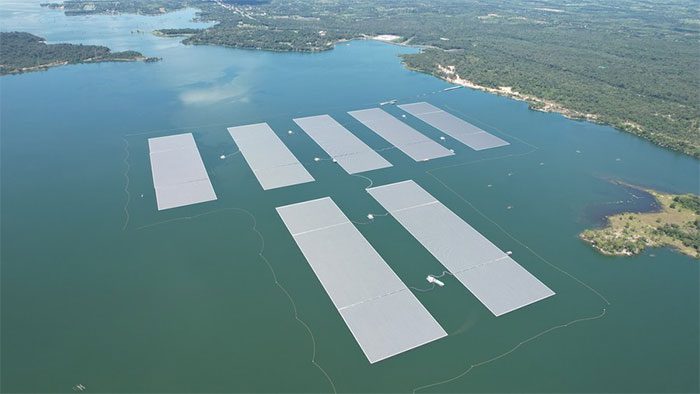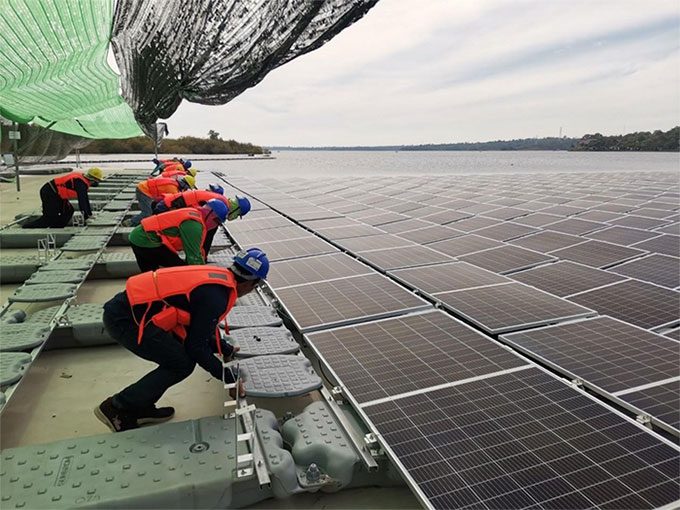The world’s largest floating solar power farm has just commenced operations in Thailand, covering an area equivalent to over a hundred football fields combined.
According to Electricity Generating Authority of Thailand (EGAT), the farm is located at the Sirindhorn Dam on the Lam Dom Noi River, in the northeastern province of Ubon Ratchathani, approximately 660 km east of Bangkok. The power plant operates using a hybrid technology model.

Overview of the wind power farm project built on Sirindhorn Dam. (Photo: EGAT)
During the day, 145,000 solar panels installed at the project are responsible for generating electricity. At night, the plant continues to produce power using three large turbines that harness the water flow below. With a total investment of 34 million USD, the Sirindhorn solar power farm has a capacity of 45 MW.
The Sirindhorn solar power farm is constructed over an area of 120 hectares at the Sirindhorn hydropower dam, the size of 120 standard football fields, with 145,000 solar panels arranged into seven zones.
According to EGAT, experts have meticulously calculated the environmental protection factors of the project. It is estimated that this solar power farm helps reduce 47,000 tons of CO2 emissions per year. All panels and floating structures are designed, installed, and operated in an environmentally friendly manner. For instance, the panels are installed at an optimal angle to maximize solar heat while not adversely affecting the surrounding water environment.
The farm occupies only about 1% of the lake’s surface area but helps retain 460,000 m³ of water from evaporating each year. The cool air from the lake surface ensures that the panels do not overheat, increasing electricity generation efficiency by 15% compared to installations on land.
Notably, the designers have also installed three turbines that can agitate the water in the lake to generate electricity when there is no sunlight or when electricity demand spikes. The Energy Management System (EMS) at the farm will operate after receiving input from weather forecasting networks to ensure stable electricity generation.
EGAT’s President Boonyanit Wongrukmit stated that this “hybrid” project enhances energy security for Thailand, contributing to the generation of clean energy that is environmentally friendly and mitigates global warming.
EGAT plans to turn this wind power farm into a tourist attraction, potentially welcoming visitors as early as next year. This project aims to raise public awareness about the trend of green, environmentally friendly energy technology, create sustainable jobs, provide stable incomes for local people, and boost economic development in the region.

Construction workers check the installation of solar panels at the project. (Photo: EGAT)
In the near future, EGAT plans to implement 15 other solar power projects. When completed, these projects will add 2,725 MW of electricity to Thailand’s national grid.
The Sirindhorn solar power plant is connected to the national grid at a time when Thailand is accelerating its goal of achieving net-zero emissions, 15 years ahead of schedule. At the 26th Conference of the Parties to the United Nations Framework Convention on Climate Change (COP26) in Glasgow, UK, in November 2021, Prime Minister Prayut Chan-o-cha committed to Thailand aiming for net-zero emissions by 2050, instead of the previously planned 2065. This is considered a significant step for Thailand, especially as 66% of the country’s electricity comes from gas-fired thermal power.
According to Bloomberg, Thailand’s total gas-fired electricity generation is 114,000 GW, while renewable energy sources such as solar, wind, and hydrogen account for only about 10% of total production. The remaining power generation is from coal-fired thermal power, which is a major contributor to increased carbon emissions.
Thailand is currently among the leading countries in ASEAN in renewable energy development, gradually liberalizing the energy market and encouraging greater private sector participation and contribution to this market.
Political officials and economic groups in the country are beginning to seriously consider the transition to clean energy, as domestic fossil fuel supplies gradually deplete. Natural gas, the largest fossil fuel source in Thailand, peaked in 2014 and is declining. Renewable energy, including solar power, has seen rapid growth since that time. The Thai government hopes that by 2037, renewable energy will contribute 35% of the national electricity production.





















































